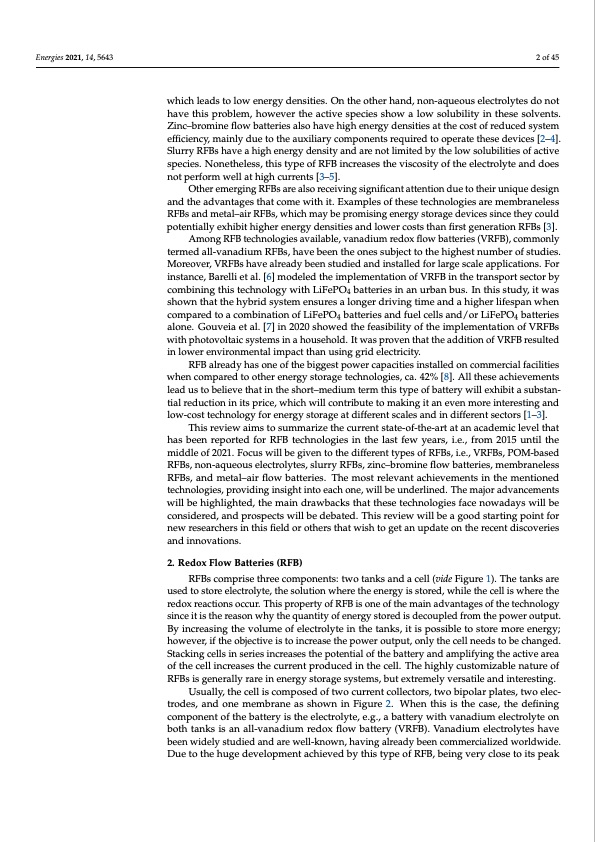
PDF Publication Title:
Text from PDF Page: 002
Energies 2021, 14, 5643 2 of 45 which leads to low energy densities. On the other hand, non-aqueous electrolytes do not have this problem, however the active species show a low solubility in these solvents. Zinc–bromine flow batteries also have high energy densities at the cost of reduced system efficiency, mainly due to the auxiliary components required to operate these devices [2–4]. Slurry RFBs have a high energy density and are not limited by the low solubilities of active species. Nonetheless, this type of RFB increases the viscosity of the electrolyte and does not perform well at high currents [3–5]. Other emerging RFBs are also receiving significant attention due to their unique design and the advantages that come with it. Examples of these technologies are membraneless RFBs and metal–air RFBs, which may be promising energy storage devices since they could potentially exhibit higher energy densities and lower costs than first generation RFBs [3]. Among RFB technologies available, vanadium redox flow batteries (VRFB), commonly termed all-vanadium RFBs, have been the ones subject to the highest number of studies. Moreover, VRFBs have already been studied and installed for large scale applications. For instance, Barelli et al. [6] modeled the implementation of VRFB in the transport sector by combining this technology with LiFePO4 batteries in an urban bus. In this study, it was shown that the hybrid system ensures a longer driving time and a higher lifespan when compared to a combination of LiFePO4 batteries and fuel cells and/or LiFePO4 batteries alone. Gouveia et al. [7] in 2020 showed the feasibility of the implementation of VRFBs with photovoltaic systems in a household. It was proven that the addition of VRFB resulted in lower environmental impact than using grid electricity. RFB already has one of the biggest power capacities installed on commercial facilities when compared to other energy storage technologies, ca. 42% [8]. All these achievements lead us to believe that in the short–medium term this type of battery will exhibit a substan- tial reduction in its price, which will contribute to making it an even more interesting and low-cost technology for energy storage at different scales and in different sectors [1–3]. This review aims to summarize the current state-of-the-art at an academic level that has been reported for RFB technologies in the last few years, i.e., from 2015 until the middle of 2021. Focus will be given to the different types of RFBs, i.e., VRFBs, POM-based RFBs, non-aqueous electrolytes, slurry RFBs, zinc–bromine flow batteries, membraneless RFBs, and metal–air flow batteries. The most relevant achievements in the mentioned technologies, providing insight into each one, will be underlined. The major advancements will be highlighted, the main drawbacks that these technologies face nowadays will be considered, and prospects will be debated. This review will be a good starting point for new researchers in this field or others that wish to get an update on the recent discoveries and innovations. 2. Redox Flow Batteries (RFB) RFBs comprise three components: two tanks and a cell (vide Figure 1). The tanks are used to store electrolyte, the solution where the energy is stored, while the cell is where the redox reactions occur. This property of RFB is one of the main advantages of the technology since it is the reason why the quantity of energy stored is decoupled from the power output. By increasing the volume of electrolyte in the tanks, it is possible to store more energy; however, if the objective is to increase the power output, only the cell needs to be changed. Stacking cells in series increases the potential of the battery and amplifying the active area of the cell increases the current produced in the cell. The highly customizable nature of RFBs is generally rare in energy storage systems, but extremely versatile and interesting. Usually, the cell is composed of two current collectors, two bipolar plates, two elec- trodes, and one membrane as shown in Figure 2. When this is the case, the defining component of the battery is the electrolyte, e.g., a battery with vanadium electrolyte on both tanks is an all-vanadium redox flow battery (VRFB). Vanadium electrolytes have been widely studied and are well-known, having already been commercialized worldwide. Due to the huge development achieved by this type of RFB, being very close to its peakPDF Image | PNNL Vanadium Redox Flow Battery Stack

PDF Search Title:
PNNL Vanadium Redox Flow Battery StackOriginal File Name Searched:
energies-14-05643-v2.pdfDIY PDF Search: Google It | Yahoo | Bing
Salgenx Redox Flow Battery Technology: Salt water flow battery technology with low cost and great energy density that can be used for power storage and thermal storage. Let us de-risk your production using our license. Our aqueous flow battery is less cost than Tesla Megapack and available faster. Redox flow battery. No membrane needed like with Vanadium, or Bromine. Salgenx flow battery
| CONTACT TEL: 608-238-6001 Email: greg@salgenx.com | RSS | AMP |